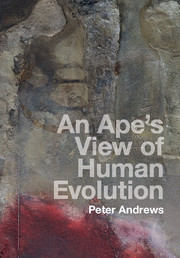Book contents
- Frontmatter
- Contents
- Preface
- 1 How can we recognize common ancestors?
- Part I Apes: their morphology and behaviour
- PART II Environments and palaeoenvironments
- Part III Review of fossil apes
- 7 The view from the early Miocene
- 8 The environment in the early Miocene
- 9 The view from the middle Miocene
- 10 Specialized apes from the middle Miocene
- 11 The environment during the middle Miocene
- 12 A second view from Europe
- 13 The environment in Europe
- 14 Late Miocene to Pleistocene apes
- 15 Apes, hominins and environment in the late Miocene
- Part IV Last common ancestor
- References and further reading
- Index
- References
7 - The view from the early Miocene
from Part III - Review of fossil apes
Published online by Cambridge University Press: 05 January 2016
- Frontmatter
- Contents
- Preface
- 1 How can we recognize common ancestors?
- Part I Apes: their morphology and behaviour
- PART II Environments and palaeoenvironments
- Part III Review of fossil apes
- 7 The view from the early Miocene
- 8 The environment in the early Miocene
- 9 The view from the middle Miocene
- 10 Specialized apes from the middle Miocene
- 11 The environment during the middle Miocene
- 12 A second view from Europe
- 13 The environment in Europe
- 14 Late Miocene to Pleistocene apes
- 15 Apes, hominins and environment in the late Miocene
- Part IV Last common ancestor
- References and further reading
- Index
- References
Summary
The genus Proconsul was first named by Arthur Tindell Hopwood from the British Museum (Natural History), now the Natural History Museum, in London. He was sent a small collection of fossils by E.J. Wayland that had been collected in western Kenya by a local doctor, H.L. Gordon. Hopwood recognized one of the fossils as the upper jaw of an anthropoid ape derived from Lower Miocene sediments, and the potential of the site became immediately obvious. Hopwood subsequently visited the site, Koru in western Kenya, and collected more fossils. He named the original ape upper jaw as Proconsul africanus and named two other taxa as well.
Wayland had visited Rusinga Island, Lake Victoria, in 1927, and he informed Louis Leakey about the fossil deposits he found there. Leakey at that time was based in Cambridge and was conducting a series of archaeological expeditions to Kenya. In 1931/32, on his third archaeological expedition, Leakey visited Rusinga Island with his assistant Donald MacInnes, and they immediately started finding fossil apes. Some of these finds were described by MacInnes in 1943, and in 1947 Leakey set up the Kenya Miocene expeditions in collaboration with Wilfred Le Gros Clark. These expeditions ran for 5 years, and they were continued off and on by Leakey for a further 15 years. Louis had supported my studies at Cambridge, and in 1969, after I completed my anthropology degree, he employed me as his research assistant to describe the Kenya Miocene fossil apes which had accumulated over the 20 years of collecting. I published my work in 1978 after I had moved to the Natural History Museum in London, and at that stage I recognized ten species of fossil ape and ape-like creatures, although this number has now more than doubled as a result of subsequent discoveries. Aided by my forestry background in Kenya, much of my work on fossil apes was combined with investigations into the environment inhabited by the apes, and when this is linked with the morphologies of the different ape species it gives us a good idea of how they lived.
- Type
- Chapter
- Information
- An Ape's View of Human Evolution , pp. 121 - 136Publisher: Cambridge University PressPrint publication year: 2016



